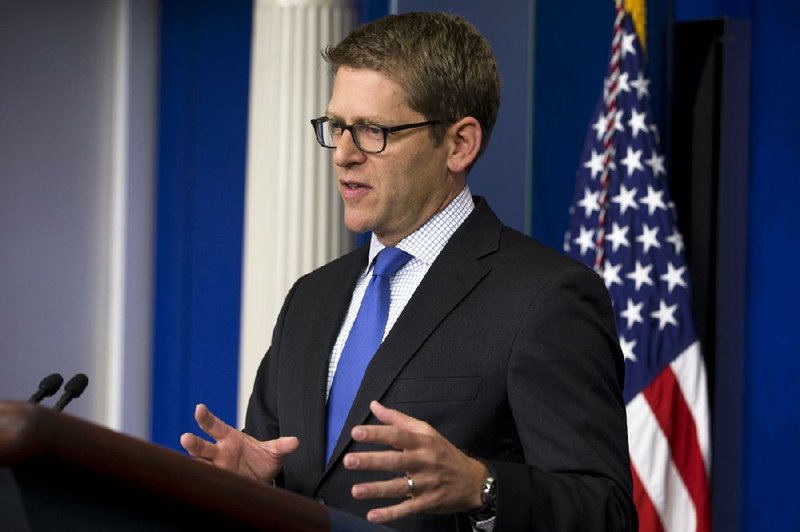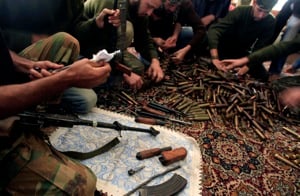WASHINGTON - President Barack Obama is considering a range of limited military actions against Syria designed to “deter and degrade” the ability of President Bashar Assad’s regime to launch chemical weapons, Pentagon officials said Tuesday.
Although no final decisions have been made, it is unlikely that the attacks would be focused on chemical-weapons storage sites, even though the Obama administration said the use of chemical weapons by the Syrian military is the trigger for the planned attack, they said. Any effort to target chemical sites risks an environmental and humanitarian disaster and could open up the sites to raids by militants.
Instead, any U.S. assault is expected to be aimed at the headquarters, facilities and depots of Assad’s most elite units, the Republican Guard and the 4th Armored Division, which some U.S. officials think are most likely to have mounted the reported chemical-weapons attack last week that opposition forces and outside aid groups say killed hundreds of people.
RELATED ARTICLE
http://www.arkansas…">Rumblings grow on striking at Syria
A U.S. official familiar with the military planning said the initial target list had fewer than 50 sites, including air bases where Syria’s Russian-made attack helicopters are deployed. The list includes command and control locations as well as a variety of conventional military targets, the official said. Like several other military officials contacted for this article, the official agreed to discuss planning options only on the condition of anonymity.
Planners said that although suspected chemical-weapons depots are seductive targets, they are too risky.
“That is a hairy business,” the official said. “Our interest is in keeping the chemical weapons secured. You hit a bunker that holds chemical weapons, and all of a sudden you have chemical weapons loose.”
Officials anticipated that a first round of attacks would be followed by a pause to assess the damage and the regime’s response before a potential second wave of strikes would be ordered. With little intelligence from people inside the country, the inspection of targets after the strike would be conducted by satellite or surveillance aircraft capable of flying above the range of Syria’s highly regarded integrated air-defense system.
Officials also cautioned that arguments for a more limited strike included the fear that the refugee flow to U.S. allies Turkey and Jordan - where the influx already is causing political concern - would increase. There are also worries that Iranian-backed Hezbollah militants might step up terrorism around the region in retaliation.
The U.S. Air Force maintains a vast fleet of fighter jets and long-range bombers in Europe and the Middle East capable of striking Syria, but a range of officials said that, for now, the strike plans were focusing solely on sea launched Tomahawk cruise missiles. They said there was no intention of putting up strike aircraft, which require a large cast of supporting aircraft, including refueling tankers, search-and-rescue aircraft, and early-warning or electronic-jamming planes.
The Navy has traditionally kept two destroyers in the eastern Mediterranean but quietly increased that number to three over recent months.
By accelerating the arrival of one replacement and delaying the return of another, the Navy now has four destroyers within striking range of Syria.
Each carries about two dozen Tomahawk cruise missiles, a low-flying, highly accurate weapon that can be launched from distances of up to about 1,000 miles and was used to open the conflicts in Afghanistan, Iraq and Libya.
Attack submarines also carrying Tomahawks are assumed to be on station in the Mediterranean as well.
But Tomahawk missile strikes, while politically and psychologically significant, can have a limited tactical effect. The weapons are largely fuel-and-guidance systems and carry relatively small high-explosive warheads. One conventional version contains about 260 pounds of explosives; the other carries about 370 pounds. That is less than the explosive power of a single 1,000-pound airdropped bomb.
The weapons also present certain technical risks. Naval officers and attack planners concede that the missiles are not entirely controllable for elevation near the target, and when they fly slightly high they carry the risk of a blast affecting structures and people behind or near the targets.
Planners also have difficulty timing the missiles - which fly from different release points and fly different routes by GPS way points - so they arrive at their targets simultaneously, which means the first strikes can alert troops at follow-up targets that attacks are imminent. Thus they are much more effective against fixed targets such as buildings or infrastructure than against military units or commanders.
A campaign extending beyond cruise missiles could add satellite-guided glide bombs dropped from Air Force F-15 or F-16 fighter jets or Navy F-18s that remain outside Syrian airspace, officials said. B-2 stealth bombers flying from their base in Missouri could drop bombs while penetrating Syria’s dense air defenses.
The B-2 can carry 80 of Boeing Co.’s 500-pound satellite-guided bombs or as many as 16 of its 2,000-pound version, each capable of hitting different targets, according to the Air Force.
The introduction of ground troops isn’t being considered, officials said, nor is the imposition of a no-fly zone.
The Syrian air force has an estimated 365 combat aircraft, 4,700 surface-to-air missiles and 4,000 shoulder-fired missiles that can strike planes, according to the International Institute for Strategic Studies.
“Syrian air defenses are dense, sophisticated, and overlapping, covering all but the easternmost parts of the country,” said Frederic Hof, a former State Department adviser on Syria.
“The idea is to keep manned aircraft out of Syrian airspace.”
Hof, now a senior fellow at the Atlantic Council in Washington, said in an email that he’s concerned the administration might opt for only “largely symbolic strikes” that stop short of the sustained attack necessary to degrade Syria’s military.
Other military analysts warned that the type of limited campaign being contemplated against Syria has failed to deter U.S. adversaries in the past.
In two major episodes in 1998, the U.S. government unleashed a combination of bombs and cruise missiles against its foes - Osama bin Laden’s al-Qaida and Saddam Hussein’s government in Iraq. In 1986, the U.S. bombed Moammar Gadhafi’s Libya.
The bombs and missiles mostly hit their targets, and the U.S. military at the time declared the attacks successful.
But in the end, they achieved little.
In 1986, after officials concluded that Gadhafi had ordered a bombing that killed two U.S. service members in a Berlin disco, President Ronald Reagan authorized an airstrike of 60 tons of munitions in 12 minutes on targets in Tripoli. Among the targets was Gadhafi’s residential compound, but he had fled after being warned.
Two years after the U.S. bombed Tripoli, Pan Am Flight 103 exploded over Lockerbie, Scotland, killing 270 passengers and crew. Investigators later concluded that the U.S. attack was a primary motive for Gadhafi to support the Lockerbie bombing.
In August 1998, days after al-Qaida bombings of American embassies in Kenya and Tanzania killed 224 people, including 12 Americans, President Bill Clinton signed off on plans to target bin Laden with cruise missiles, and the U.S. fired 75 of them into terrorist training camps in Afghanistan.
Clinton’s operation also targeted a pharmaceutical factory in Sudan that U.S. officials thought was making chemical weapons. Later evidence cast doubt on that claim.
Bin Laden and many of his top lieutenants escaped unharmed, and al-Qaida killed nearly 3,000 people in attacks on the United States on Sept. 11, 2001. The U.S. invaded Afghanistan after the 2001 attacks when the Taliban refused to hand over bin Laden.
In December 1998, Clinton ordered an operation designed to “strike military targets in Iraq that contributed to its ability to produce, store, maintain and deliver weapons of mass destruction,” according to a Pentagon history.
Later evidence showed Saddam had shelved his banned weapons programs by then, but the attacks were at the time considered a military success, having inflicted serious damage on Iraq’s missile development program.
However, Saddam kicked out international weapons inspectors and stayed in power despite sanctions until a U.S.-led invasion deposed him in 2003. The benefit to the U.S. of that war and the occupation that followed remains in dispute.
Military analysts now are warning about the limits of using such an approach in Syria.
“If the U.S. does something and Assad is left standing at the end of it without having suffered real serious, painful enough damage, the U.S. looks weak and foolish,” said Eliot Cohen, a professor at the Johns Hopkins School of Advanced International Studies, and former State Department official.
“Can you do damage with cruise missiles? Yes,” said Anthony Cordesman, military analyst with the Center for Strategic and International Studies, a Washington think tank. “Can you stop them from having chemical-weapons capability? I would think the answer would be no. Should you limit yourself to just a kind of incremental retaliation? That doesn’t serve any strategic purpose. It doesn’t protect the Syrian people, it doesn’t push Assad out.”
Information for this article was contributed by Thom Shanker, C.J. Chivers and Michael R. Gordon of The New York Times; by Ken Dilanian of the Tribune Washington Bureau; and by Tony Capaccio, David Lerman and Donna Abu-Nasr of Bloomberg News.
Front Section, Pages 1 on 08/28/2013

